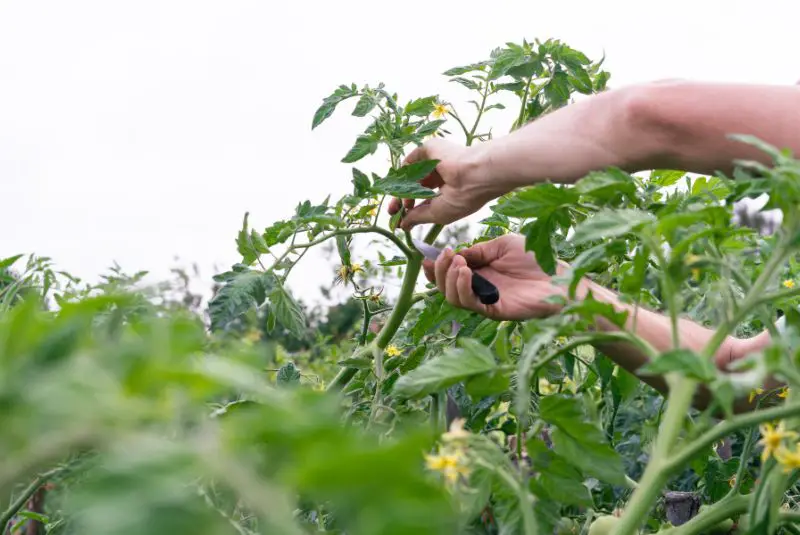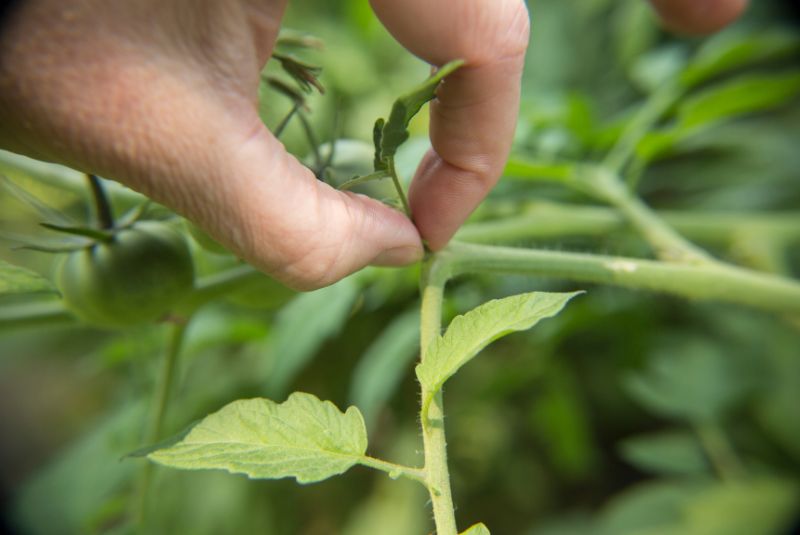7 Common Tomato Pruning Mistakes You Need to Avoid
Tomato gardening is a bit like raising kids—sometimes you’re not sure if you’re doing it right, but you’re doing your best! If you’re like me, you’ve probably made a few pruning mistakes along the way.
Don’t worry, you’re not alone. Many gardeners unknowingly make common errors that can affect their tomato yield and plant health.

1. Recognizing the Type of Tomato Plant
Knowing your tomato plant type is key to pruning correctly and boosting your tomato yield.
Differences Between Determinate and Indeterminate Tomatoes
Determinate tomatoes, also called bush tomatoes, grow to a certain height, usually between 3 and 4 feet. They stop growing once fruit sets on the top bud.
This results in all the fruits ripening around the same time. Indeterminate tomatoes, or vining tomatoes, keep growing and producing fruit throughout the season.
These plants can get as tall as 6 to 7 feet and need strong support.
Tailoring Pruning Techniques to Plant Type
For determinate tomatoes, less pruning is needed since these plants have a defined growth limit. Removing excessive suckers can reduce your overall yield.
Indeterminate tomatoes require more vigilant pruning. Pinch off the suckers regularly to prevent the plant from getting too dense.
This will ensure good airflow, reduce disease risk, and direct energy towards fruit production.

2. Timing Your Pruning Correctly
Timing your pruning can make a huge difference in the health and productivity of your tomato plants.
The Risks of Pruning Too Early or Too Late
Pruning too early can stress your tomato plant. When you cut away new growth before the plant’s fully established, you risk stunting its development. This leads to fewer blossoms and, ultimately, less fruit.
On the other hand, waiting too long to prune can result in a tangled mess of growth. Overgrown tomato plants create a dense environment that’s perfect for pests and diseases.
Plus, late pruning may expose previously shaded parts of the plant to harsh sunlight, causing sunscald.
Signs That Your Tomato Plant Is Ready for Pruning
Look for a sturdy main stem to indicate readiness for pruning. The plant should be at least 12-18 inches tall before you start removing suckers. Check for suckers that are smaller than a pencil.
Pinch or cut these off early for the best results.
Also, observe the first flower cluster: if it’s appeared, your plant is mature enough for selective pruning. Always choose cooler parts of the day, like early morning or late evening, to avoid stressing the plant with intense heat right after pruning.
3. Not Using Proper Pruning Techniques
Effective pruning is key for healthy tomato plants that produce a bountiful harvest.

Identifying Which Stems and Suckers to Remove
Focus on removing the new offshoots, known as suckers, which grow in the joint between the main stem and the side stem. These suckers drain nutrients from the plant, making it less effective at producing fruit.
The best time to prune suckers is when they’re smaller than a pencil. You can pinch them off with your fingers or use a sharp pair of gardening shears.
For a balanced approach, pinch suckers off at the tip instead of the base to allow the plant to produce shade leaves while conserving energy for fruit growth.
Avoiding Over-Pruning to Prevent Sunscald
Over-pruning can lead to sunscald on your tomatoes since excessive leaf removal exposes the fruit directly to the sun. Always leave enough foliage to shade the fruits.
Prune in moderation, focusing on removing only the necessary suckers and dead or yellowing leaves. Aim to maintain a balance between allowing airflow and providing shade to protect your developing tomatoes.
4. Pruning in Wet Conditions
Pruning tomato plants when conditions aren’t right can seriously impact their health and productivity.

Why You Should Never Prune Wet Tomato Plants
Pruning wet tomato plants invites disease. Fungi and bacteria thrive in moisture, so cutting into wet stems and leaves creates easy entry points for these harmful agents.
If your plants are damp from rain or watering, wait until they’re completely dry before making any cuts. This small step can help keep your tomato plants healthy and disease-free.
The Effect of Humidity and Rain on Pruning
High humidity and rain exacerbate the spread of diseases. Pruning during or right after it rains significantly increases the risk of fungal and bacterial infections.
Moisture-loving pathogens like blight and mold can quickly take over, damaging your plant. Always choose to prune on dry days and keep an eye on the weather forecast to avoid these issues.
The extra caution ensures your tomatoes stay robust and fruitful throughout the growing season.
5. Not Using the Right Tools for Pruning
Having the right tool for the job makes all the difference, especially when it comes to pruning tomato plants.

Importance of Clean and Sharp Tools
Clean and sharp tools are essential for effective pruning. When you’ve got a good pair of pruning shears, you’ll be able to make clean cuts that heal quickly.
This reduces the risk of fungal problems and disease. I always make sure to disinfect my tools with rubbing alcohol before and after use, especially if I’m pruning wet plants. This way, I keep my plants healthy and thriving.
How Dirty or Dull Tools Can Harm Your Plants
Using dirty or dull tools can be a disaster for your tomato plants. When tools are dull, they tend to squish the stem instead of slicing through it cleanly. This damages stem tissue and makes the plant more susceptible to disease.
Dirty tools, on the other hand, can transfer harmful pathogens from one plant to another. To avoid these issues, regularly clean and sharpen your pruning tools, ensuring they are in top condition every time you use them.
6. Not Properly Maintaining Pruning Tools
Keeping your pruning tools in top shape is key to healthy tomato plants.

Regular Cleaning and Sharpening
Clean tools help prevent the spread of diseases from one plant to another. After working on each plant, I wipe down my pruners with rubbing alcohol. This step is simple but key.
Sharp tools make cleaner cuts, reducing stress on the plant. I sharpen my pruning shears before the start of the season and touch them up as needed.
Best Practices for Tool Maintenance
Proper maintenance extends the life of your tools. I store my pruners in a dry place to prevent rust. Occasionally, I oil the pivot points to keep everything running smoothly.
Checking for loose screws and making adjustments keeps my tools reliable. A little care goes a long way in making sure I’m always ready for garden work.
7. Neglecting End of Growing Season Pruning

Ignoring end-of-season pruning can hurt your tomato plants. As the growing season winds down, plants shift their energy from fruit production to producing new foliage.
Removing excessive foliage helps redirect energy to ripening existing tomatoes. Use pruning shears to cut back the top of the plant, especially if it’s still growing vigorously.
Eliminating new flowers and small fruits can increase your plant’s productivity. Late-season blooms and tiny fruits often don’t mature before the first frost, so they end up wasting valuable resources.
Snip these off to help the plant focus on the remaining, larger fruit.
Clearing out dead or diseased leaves reduces the risk of diseases spreading in cooler, wetter autumn weather. Discard all removed plant material properly to prevent any fungal spores or pests from lingering in your garden.
Regular cleanup keeps your plants and soil healthier.
Simplifying your plant’s structure can make late-season harvests easier. Thinning out dense foliage improves air circulation, reduces excess moisture, and allows more sunlight to reach the fruit.
This helps the remaining tomatoes to ripen more evenly and quickly.
Preparing your plants for frost is key if you live in an area prone to early frosts. Cover the plants with a garden fabric or move potted plants to a sheltered area.
Pruning helps make the covering process more manageable and effective. Ensure you’re taking all steps to protect the last harvest of the season.
By focusing on these end-of-season pruning practices, your tomato plants can remain productive and healthy.